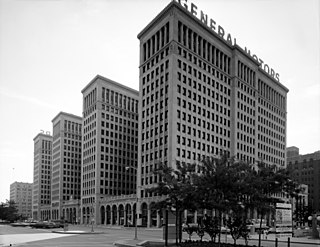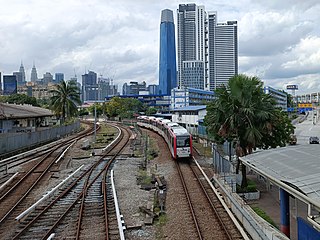
A people mover or automated people mover (APM) is a type of small scale automated guideway transit system. The term is generally used only to describe systems serving relatively small areas such as airports, downtown districts or theme parks.

Line 3 Scarborough is a light rapid transit line that is part of the Toronto subway system in Toronto, Ontario, Canada. The line runs entirely within the suburban district of Scarborough, encompassing six stations and 6.4 kilometres (4.0 mi) of mostly elevated track. It connects with Line 2 Bloor–Danforth at its southwestern terminus, Kennedy, and terminates in the northeast at McCowan. In 2021, the system had a ridership of 2,822,300, or about 10,800 per weekday as of the first quarter of 2022.
Thales Group is a French multinational company that designs, develops and manufactures electrical systems as well as devices and equipment for the aerospace, defence, transportation and security sectors. The company is headquartered in Paris' business district, La Défense, and its stock is listed on the Euronext Paris.

The Tsuen Wan line is one of the eleven lines of the metro network in Hong Kong's MTR. It is indicated in red on the MTR map.

The General Motors streetcar conspiracy refers to the convictions of General Motors (GM) and related companies that were involved in the monopolizing of the sale of buses and supplies to National City Lines (NCL) and subsidiaries, as well as to the allegations that the defendants conspired to own or control transit systems, in violation of Section 1 of the Sherman Antitrust Act. This suit created lingering suspicions that the defendants had in fact plotted to dismantle streetcar systems in many cities in the United States as an attempt to monopolize surface transportation.

Innovia Metro is an automated rapid transit system manufactured by Alstom. Innovia Metro systems run on conventional metal rails and pull power from a third rail, but are powered by a linear induction motor that provides traction by pulling on a "fourth rail" placed between the running rails. A new version of the technology being marketed by Bombardier is compatible with standard electric rotary propulsion.

The Toronto subway is a rapid transit system serving Toronto and the neighbouring city of Vaughan in Ontario, Canada, operated by the Toronto Transit Commission (TTC). It is a multimodal rail network consisting of three heavy-capacity rail lines operating predominantly underground, and one elevated medium-capacity rail line. Two light rail lines, which will operate both at-grade and underground, are under construction.

Automatic train operation (ATO) is an operational safety enhancement device used to help automate the operation of trains. The degree of automation is indicated by the Grade of Automation (GoA), up to GoA level 4 in which where the train is automatically controlled without any staff on board. ATO is primarily used on automated guideway transit and rapid transit systems where it is easier to ensure the safety of people. On most systems, there is a driver present to mitigate risks associated with failures or emergencies.

The Urban Transportation Development Corporation Ltd. (UTDC) was a Crown corporation owned by the Government of Ontario, Canada. It was established in the 1970s as a way to enter what was then expected to be a burgeoning market in advanced light rail mass transit systems. UTDC built a respected team of engineers and project managers. It developed significant expertise in linear propulsion, steerable trucks and driverless system controls which were integrated into a transit system known as the Intermediate Capacity Transit System (ICTS). It was designed to provide service at rider levels between a traditional subway on the upper end and buses and streetcars on the lower, filling a niche aimed at suburbs that were otherwise expensive to service.
Bombardier Transportation was a Canadian-German rolling stock and rail transport manufacturer, headquartered in Berlin, Germany.
Safetran Systems Corporation was an American company that manufactured switch machines, railroad wayside signal systems, rail transit signaling and rail-highway level crossing active warning systems.
The Toronto subway uses a variety of signalling systems on its lines, consisting of a combination of fixed block signalling and moving block signalling technologies.
SelTrac is a digital railway signalling technology used to automatically control the movements of rail vehicles. It was the first fully automatic moving-block signalling system to be commercially implemented.
GO ALRT was a rapid transit system proposed by GO Transit in 1982. The ALRT system would have been implemented along two new lines in the Greater Toronto Area. It would have used a new electric train to provide interurban service, also then referred to as "inter-regional rapid transit", along the existing and new GO corridors. The system was based on an enlarged UTDC ICTS vehicle that was designed to offer a compromise between passenger capacity and the level of infrastructure needed to support it. The project was cancelled due to budget cuts of the Tory government in 1985, although a number of the proposed lines were later implemented using conventional heavy rail systems, including the eastern portion of the Lakeshore East GO train service route from Pickering station, to Whitby station, in Durham region.
Hitachi Rail Signalling and Transportation Systems or Hitachi Rail STS is a transportation company owned by Hitachi with a global presence in the field of railway signalling and integrated transport systems for passenger traffic and freight operations. Hitachi Rail STS plans, designs, manufactures, installs and commissions signaling systems, components and high technologies for the management and control of newly built or upgraded railways, transit and freight lines worldwide.

The LRT Ampang Line and the LRT Sri Petaling Line are medium-capacity light rapid transit (LRT) lines in the Klang Valley, Malaysia. The combined network comprises 45.1 kilometres of tracks with 36 stations and was the first railway in Malaysia to use standard-gauge track and semi-automated trains. It is operated as part of the RapidKL system by Rapid Rail, a subsidiary of Prasarana Malaysia.
Krauss-Maffei's Transurban was a 12-passenger automated guideway transit (AGT) mass transit system based on a maglev guideway. Development started in 1970 as one of the many AGT and PRT projects that followed in the wake of the HUD reports of 1968. Its selection as the basis of the GO-Urban system in Toronto in 1973 made it well known in the industry; it would have been the basis of the first large-area AGT mass transit network in the world. Technical problems cropped up during the construction of the test track, and the sudden removal of funding by the West German government led to the project's cancellation in late 1974. The Ontario government completed development and installation of a non-maglev version, today known as the Bombardier Advanced Rapid Transit.

Communications-based train control (CBTC) is a railway signaling system that uses telecommunications between the train and track equipment for traffic management and infrastructure control. CBTC allows a train's position to be known more accurately than with traditional signaling systems. This makes railway traffic management safer and more efficient. Metros are able to reduce headways while maintaining or even improving safety.









